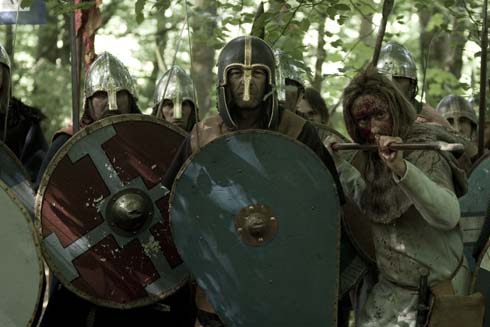This is superb introduction to Roman roads in Britain. It is 72 pages long (including indices) and has plenty of colour photographs, diagrams and several aerial shots to illustrate Hugh Davies’ concise discussion of our Roman roads.
Hugh Davies spent his working life as a highway engineer with the Transport Research Laboratory. He retired in 1994 and gained a PhD in 2001 from the Archaeology and Classics Departments of Reading University. He has since written extensively on Roman roads using his expert knowledge of road building and design. He is also the author of Roads in Roman Britain which is based on his five years of academic research and From Trackways to Motorways: 5000 Years of Highway History.
In this slim, handy book Davies sets out to show that as soon as the Romans began their invasion of Britain in the late summer of AD43, they started to build a network of roads that rivals in length and solidity Britain’s modern motorway and trunk road system. The book describes what is known of the Roman road network, how and why it was built, and the ways in which its influence can still be traced in the modern landscape. In short, it demonstrates the tenacity and imperial ambition of the Roman Empire, and describes how even before arriving on these shores, the conquest and its aftermath had all been meticulously thought through and planned.
How The Romans Paved The Way
There are many aspects to be considered. Without roads, would the Roman army have been able to get as far as modern-day Scotland? Without roads, would Roman civilisation have spread so effectively and lasted for almost 400 years? The establishment of the road system throughout the Roman province of Britain was crucial to all that we take for granted when discussing the impact and legacy of the Romans in Britain.
“The roads were needed initially to support the military occupation, allowing troops, equipment and supplies to be moved efficiently,” writes Davies. “But there soon arose a need for civilian travel as well, to and from newly created Roman towns. Urban life was something quite new to Iron Age Britain, but was an essential element of being part of the Roman Empire.”
Any yet “…finding out precisely how and why the roads were built is not as straight forward as might be expected. Very little written material about road-building has survived from the Roman era; in particular there are no engineering manuals or training instructions for road-builders…”
Ancient Engineering
In clear prose, Davies leads the reader through his theories as to how the Romans built such a fantastic and solid road network system. He examines the purpose of those roads for the Romans and elaborates on why Roman roads tended to be straight. He discusses the importance of Roman milestones – the most famous example being in its original place at Vindolanda – and he also provides the lesser known example of the broken milestone a Roman mile away on the Stanegate into/out of Vindolanda.
Within the fascinating third chapter, Davies also examines how the Roman army actually constructed the roads (diagram fig. 25 on page 33 shows a Roman road cross-section), while providing photographs of existing roads, culverts, ramps and the like. He even considers the question of road widths: could they be an indicator of status?
Davies pays tribute to Ivan Margery’s Roman Roads in Britain, which was first published in the 1950s. Margary is the originator of the Roman road numbering system (which is explained by Davies in chapter 4).
This book is perfect for a dedicated Roman enthusiast, though it may be more suitable to a beginner. Its size and shape make it very easy to slip into a rucksack – it encourages the reader to explore his /her own local roads for further evidence of the Romans. A good accompaniment would also be The Ordnance Survey’s Map of Roman Britain, although as Davies points out, we in Britain are very fortunate that Roman roads are also often clearly identified on normal maps.





